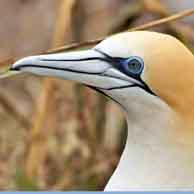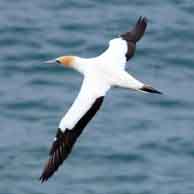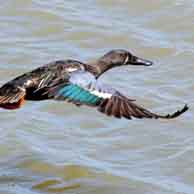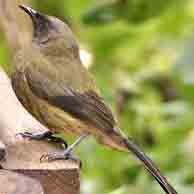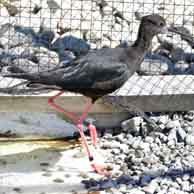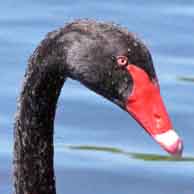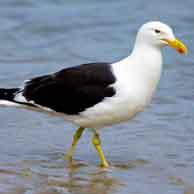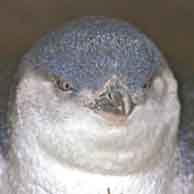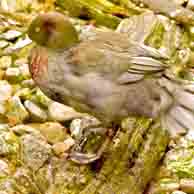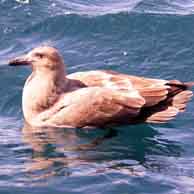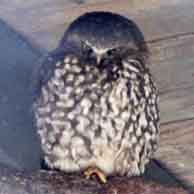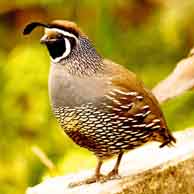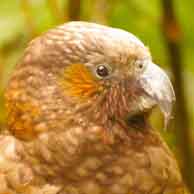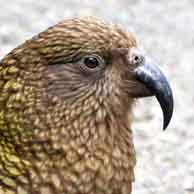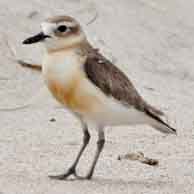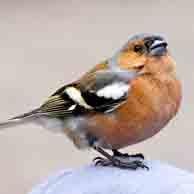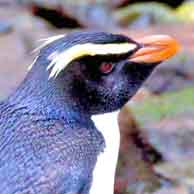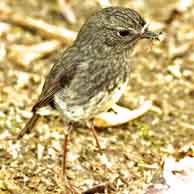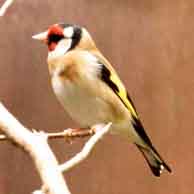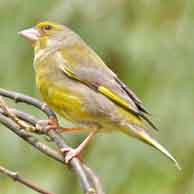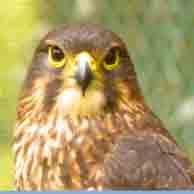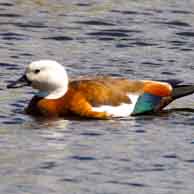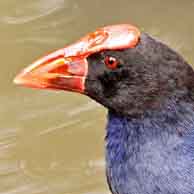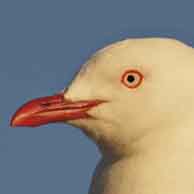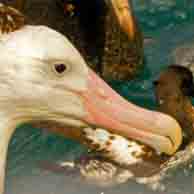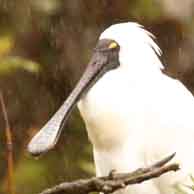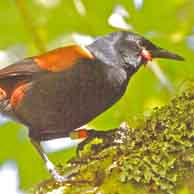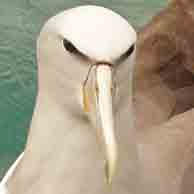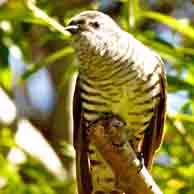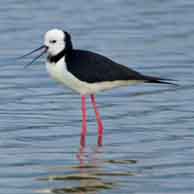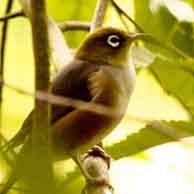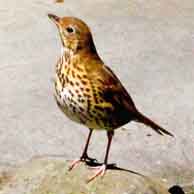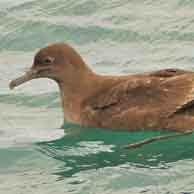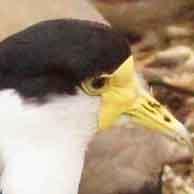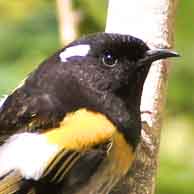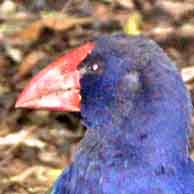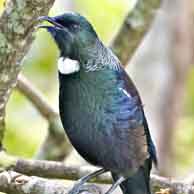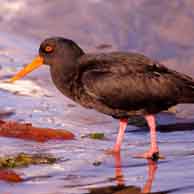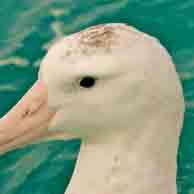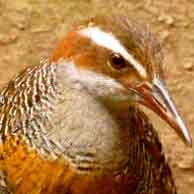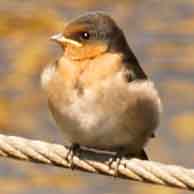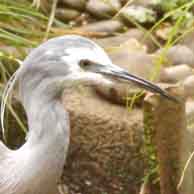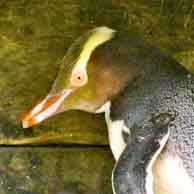Click to return to: www.ComingsBirds.com
In the years before either the Māori or the Europeans came to New Zealand there were no mammalian predators on the islands making it a paradise for birds. The birds were king. Just as the dinosaurs had been king millions of years earlier. As a result of this lack of mammals many of the birds lost the function of their wings, since they did not have to flee from mammalian predation. This winglessness was especially apparent for the Kiwis, but also for other birds, including many now extinct.
Due to vigorous conservation efforts by the New Zealanders to develop predator free islands and fenced areas of land, many of the birds that were so susceptible to the introduced mammalian species are now still able to thrive, making birding in New Zealand a most delightful adventure.
While attending the 2010 Festival of the Cranes at Bosque del Apache, New Mexico, I meet Gail Garber, executive director of Hawks Aloft. She showed me a copy of a three week New Zealand birding trip she was planning for the following November. Since Sally’s son Mark had a house near New Plymouth that we wanted to see, this was the perfect opportunity and I signed us up on the spot.
We left a week before the birding tour began to give us time to visit New Plymouth and other interesting areas on the North Island. Based on my appetite for taking bird photos in zoos and aviaries (see www.ComingsBirds.com/Discoverycove and www.ComingsBirds.com/CAZoos) I chose four zoos on the North Island – the Auckland Zoo, Rainbow Springs Nature Preserve, Otorohanga Kiwi House and the New Plymouth Zoo, and two on the South Island – Invercargill Aviary and Dunedin Aviary. These places included both native and endemic New Zealand birds that were likely to be difficult to get close up photos of such as the Blue Duck and New Zealand Falcon, and birds of the neighboring country, Australia. Most of the non-New Zealand birds were Doves, Parrots, Parakeets and related small highly colored birds suitable for zoo exhibits. To help keep this site mostly restricted to New Zealand birds, these others occur mostly in the Doves Australian, Parrots, and Parakeets folders.
One of the notable features of New Zealand birds is that even though they are in the wild many of the birds are banded. One expects this in a zoo or aviary but because of the intense conservation efforts in New Zealand most wild birds are also banded, especially in preserves that are free of mammals.
The other person on the tour with a big lens (a Canon 100-400 mm) was Bonnie Long. She got a lot of great shots, some of which I have incorporated in this site. Her photos will have a B in the title. Other contributors of some photos were Charles Cummings with a C in the title and the guide Gail Gerber, with a G in the title.
The bird guide we used was Robertson and Heather The Hand Guide to the Birds of New Zealand Revised Edition (2005). However, I would also recommend a beautiful desktop book, the Readers Digest Complete Book of New Zealand Birds (1985). Even though it is 20 years old the photographs are absolutely outstanding and taken in high resolution, pre-digital era, Kodachrome film. Used copies of this classic, in excellent condition, are available on Amazon for less than $50. I thank Wikipedia for items related to classification, description and range of many of the birds.
FOR A QUICK REVIEW OF ALL THE NEW ZEALAND BIRDS CLICK SLIDESHOW.
IMPORTANT NOTE: FOLDERS CONTAINING MULTIPLE SPECIES ARE CAPiTALIZED. WHEN OPENED A FINE LINE APPEARS AT THE BOTTOM OF THE LIGHT BLUE SECTION OF THE WEB PAGE. CLICK ON THE INDIVIDUAL SPECIES TO OPEN THEIR FOLDERS.
TO SEE THOSE PHOTOGRAPHS ENLARGED DOUBLE CLICK ON THE FIRST PHOTO AND THEN PROGRESS BY CLICKING "NEXT.'
For those who are interested, I have attached below a copy of Gail’s itinerary. If it looks like a wonderful trip - it was.
TRIP ITINERARY November 2011
Fri 11 ARRIVE AUCKLAND
Arrive Auckland International Airport.
Sat 12 AUCKLAND / MURIWAI / PAKIRI / SNELLS BEACH
8.30 am You will be met at your hotel by your charter coach driver. Travel by coach out to Muriwai Beach on the Tasman Sea Coast to view the Australian Gannet colony.
Afterwards drive north east to Pakiri on the Pacific Coast to view a Fairy Terns. At Pakiri, make your way to the council carpark arriving at 3:00pm. Eliane will be waiting to guide you across the river. Please call her ahead to confirm your arrival time. 027 414 6326. Be prepared to get wet legs even though it will be low tide. The fairy terns, one pair, are on the other side of the river. You will also see NZ Dotterel chicks, Variable Oystercatcher chicks, nests of both species and 1 Caspian Tern.
Afterwards drive on to your accommodation. The balance of afternoon is at leisure.
The Salty Inn is located at Snell’s Beach on Kawau Bay. It blends old English character and style with modern appointments. Your accommodation is in a deluxe grade studio room with en suite facilities, king size bed, Sky TV, fridge and Internet access. There are laundry facilities on site.
Accommodation: Salty Dog Inn
Sun 13 TIRITIRI MATANGI ISLAND / MIRANDA
It is vital Tiritiri Matangi remains pest free. Before departure, check bags for rodents & insects & ensure footwear, clothing & bags are clean & free of seeds and soil. Please ensure your lunch is packed in a rodent-proof container such as hard plastic. No open bags or boxes, all should be sealed/ zipped closed. Chilli bins and zipped packs are fine, open shopping bags are not. If you are unsure please ask the sales staff or boat crew. Please note there is no food available for purchase on the island. Occasionally weather conditions prohibit 360 Discovery from travelling to the island.
Please call 0800 FANTAIL (0800 326 8245) after 7:00am on the day of your trip for confirmation.
8.00 am Drive south to Gulf Harbor on the Whangaparoa peninsula.
9.20 am Report to the 'Z' Pier at the end of Laurie Southwick Parade at Gulf Harbor Marina.
9.50 am Board the 360 Discovery Cruises ferry for the quick trip across to Tiritiri Matangi Island. This island, which is located in the Hauraki Gulf off shore from Auckland, is a Department of Conservation bird sanctuary. It has been cleared of rats, cats and other predators allowing many of New Zealand’s rarest and most endangered species to breed in relative safety. Among the birds to be seen here are the Takahe – thought to be extinct until discovered in 1947 in a remote part of Fiordland National Park. Even today there are only about 250 of them in the whole world. There are also saddlebacks, stitch birds, bellbirds, tui, wood pigeons, bush robins and the kokako, which may be seen. A 60-minute guided tour will be provided on arrival on the island and then you are free to roam the island yourselves looking for the birds or taking a swim at Hobbs Beach.
4.50 pm Arrive back in Auckland on the ferry. You will be met at 360 Discovery Cruises at Pier 4, Quay Street by your coach driver for a drive of about 75 minutes to Miranda on the Firth of Thames.
Prepare own dinner in communal kitchen at Miranda or drive to Kaiaua to local pub for a pub meal.
Bunk room accommodations. Bedding linen provided.
Accommodation: Miranda Shorebird Centre
Mon 14 MIRANDA / MT KAKEPUKU / MAUNGATAUTARI
(D) Prepare own breakfast.
Spend the morning birding. High tide is predicted for approximately 9.00am.
Leave Miranda at approximately 11.00am. Afterwards drive east through Kihikihi to Out in the Styx, which is located in the shadow of Mt Maungatautari.
2.30 pm Meet guide Sue Reid at the Maungatautari fenceline up Tari Road. Maungatautari is an ‘ecological island’ where 47-kms of predator proof fence has been erected to allow birds a safe breeding area. The birds are free to come and go but predators are excluded.
Note that the walk to the sanctuary is rough, steep and uneven territory. Among the birds you might see are Kakas – large and very noisy mountain parrots, Takahe, Kakariki, Kiwi, Stitchbird, Bellbirds, Kingfisher, Fantails and Tui.
Dinner at Out in the Styx. Your hosts are Lance and Mary Hodgson
After dinner at the lodge, conditions permitting walk up to the Maungatautari Ecological Island Reserve to listen for and, hopefully see New Zealand’s nocturnal emblem bird – the rare and flightless Kiwi. Lance will provide some flashlights for your use.
Note that the walk to the sanctuary may be rough, steep and uneven territory.
Accommodation: Out in the Styx Café & Guest House
Tue 15 MAUNGATAUTARI / AUCKLAND / WELLINGTON (by air)
(B)
Spend time this morning birding in the forest – unguided.
Drive back north to Auckland Domestic Airport for an afternoon flight to Wellington.
1.45 pm Check in for Air New Zealand flight NZ457.
2.30 pm Depart Auckland.
3.30 pm Arrive Wellington Airport. Transfer to your hotel.
Your hotel is centrally located close to the cable car, most Government Offices and Parliament Buildings. There is a bar and restaurant on-site and a wide choice of restaurants, cafés and bars within easy walking distance.
Accommodation: Ibis Wellington Hotel
Wed 16 WELLINGTON / KAPITI ISLAND
(BD) Breakfast at the hotel.
8.15 am Depart the hotel and transfer to Zealandia.
8.30 am This morning visit The Zealandia Wildlife Sanctuary at Karori for a guided tour. Karori is the first ‘ecological island’ to be fenced in New Zealand from rodents, stoats, cats and other predators in an effort to allow rare and endangered native birds to inhabit the area in relative safety.
1.00 pm Depart Wellington and travel north by coach to Paraparaumu.
2.00 pm Report to the Kapiti Boating Club, corner Marine Parade and Kapiti Road, Paraparaumu Beach.
2.30 pm Depart Paraparaumu Beach by ferry for a 15-minute ride to Kapiti Island.
On arrival take the ferry across to Kapiti Island Wildlife Sanctuary where you will be met and welcomed with a traditional Maori powhiri (welcome) by members of the Barrett whanau (family) who manage Kapiti Island Nature Tours and Kapiti Nature Lodge. After a Biosecurity check and lodge check there will be a short briefing over a cup of tea/coffee, then go birding until dinner time (approx 3-hours)
7.30 pm Dinner at the lodge.
9.00 pm Go Kiwi Spotting.
Accommodation: Kapiti Island Nature Lodge
Thu 17 KAPITI ISLAND / WELLINGTON
(BL) Breakfast at the lodge.
After a short briefing on today’s site and opportunities, go birding. Day packs only required for time at the Rangatira area where Hihi, Tieke and Kokako can be seen. A packed lunch will be provided.
3.00 pm Return to the mainland by ferry and transfer back to Wellington by coach.
Accommodation: Ibis Wellington Hotel
Fri 18 WELLINGTON / PICTON / KAIKOURA
(B) Breakfast at the hotel.
7.15 am Depart the hotel and transfer to the Interislander Ferry Terminal.
7.40 am Report to the Interislander Ferry Terminal and collect boarding passes. Check your luggage through to Kaikoura.
8.25 am Depart Wellington on the Interislander Ferry and cruise across Cook Strait to Picton on the South Island. The last part of the voyage through Queen Charlotte Sound is especially scenic.
11.35 am Arrive in Picton and walk across to the nearby Railway Station.
1.00 pm Depart Picton on the Tranz Coastal train for a scenic journey to Christchurch, travelling through Blenheim and the Marlborough wine region and down the Pacific Coast to Kaikoura, which is a popular place for whale watching.
3.28 pm Arrive in Kaikoura. You will be met by your charter coach driver. Transfer to your accommodation.
Today please call Albatross Encounter (0800 733 365) and reconfirm arrangements for your pelagic birds cruise tomorrow. You will be advised of your reporting time and the expected tour conditions.
Your accommodation is situated on the waterfront and close to the town centre with stunning sea and mountain views.
Accommodation: White Morph Motor Inn
Sat 19 PELAGIC BIRDS / PUNAKAIKI
(B) Breakfast at the hotel.
Due to the currents off the coast Kaikoura is a rich feeding area for seals, whales, dolphins and birds - the largest number of different varieties of seabirds within this one small area than anywhere else in New Zealand – including albatross, petrels, shearwaters, terns, shags and gulls.
Report to the Encounter Kaikoura building. Dress warmly, wear flat comfortable shoes and take a camera.
9.00 am This morning take a Pelagic Birds Cruise – duration approximately 2½-hours. Kaikoura is renowned as one of the best places in New Zealand to see an extensive variety of pelagic birds in close proximity to land.
All tours are dependent upon suitable weather and sea conditions. Decisions regarding tour status are made at the tour time.
If you suffer from motion sickness, it is advisable to take precautions prior to departure. Time spent out on the ocean is approximately 2-2½ hours and even with the assistance of medication, there is no guarantee against the effects of motion sickness. Seasickness is not grounds for seeking a refund for the tour.
In the afternoon drive across the Lewis Pass to the West Coast and north to Punakaiki.
Transfer by coach to meet your guide for a guided Black Petrel tour.
Recommend good raincoats/leggings, warm clothing and waterproof boots if possible.
8.15 pm Meet your guide Bruce Menteath. Meeting point is 3-km south of the pancake rocks. Look for a yellow sign with a black petrel hanging on the seaward side of the road.
There is a short walk - and, in fine weather, a small stream crossing - to get to the start of the walkway, so waterproof boots would be an advantage. Also, the walkway consists of a stairway up a steep bush clad slope, so reasonable fitness would help, though there will be plenty of time to get up to the viewing shelter before the petrels begin to come out of their burrows.
Viewing is from a walkway/boardwalk and viewing shelter within a sub-colony of about 80 breeding pairs. The breeding season starts in March and the single egg per pair hatches in late July/August. The chick remains inside its burrow until it is fully grown. By November fledglings are very active around the viewing shelter and close views are the norm. Indeed, the fledglings often come onto the viewing shelter and use the seats to practice their take-offs. The fledglings may be seen in various states of plumage from fully down covered to fully adult feathered. Only occasional adult petrels visit the colony once the young birds become active outside their burrows.
Ground rules for visiting the colony:
Tour is approximately 2-hours duration. At the conclusion of the tour, transfer back to your hotel.
Your accommodation is in a modern complex which has been built to harmonize with the environment and spectacular beachfront location. Full dining facilities are available in the Waterline Restaurant and Bar. It is a short walk to the famous Pancake Rocks and Blowholes.
Accommodation: Punakaiki Resort
Sun 20 PUNAKAIKI / FRANZ JOSEF GLACIER
(B) Breakfast at the resort.
Today drive down the West Coast through Greymouth and Hokitika with the Southern Alps to the east and the Tasman Sea to the west.
12.40 pm Report to the White Heron Sanctuary Tours office at Whataroa. Wet weather gear will be provided if necessary.
At Okarito take a tour to the White Heron Colony. This 3-hour tour starts with a short coach ride to Okarito followed by a gentle 20-minutes in a jetboat and a 500-metre walk through native bush to view the birds. The Royal Spoonbill and the Little Shag also nest here. The white herons are migratory and are in New Zealand over summer months only.
Afterwards continue south to the village of Franz Josef.
Your hotel is centrally located within easy walk of a choice of cafés and bars. All rooms have Sky TV, fridges and tea/coffee making facilities.
Accommodation: Scenic Hotel Franz Josef Glacier
Mon 21 FRANZ JOSEF / WANAKA
(B) Breakfast at the hotel.
The Franz Josef Glacier is a huge river of snow and ice that flows from vast snowfields high in the Southern Alps almost to sea level, which is quite unusual in a temperate climate. Opportunity to view the glacier – do note that conditions may be such that it will be better to stop at Fox and view the Fox Glacier from the lookout there.
Drive south to Fox where, if the weather is calm and clear you may want to stop for a walk to Lake Matheson for views of Mts Cook and Tasman reflected in the lake. Then continue south to Haast and over the pass to Wanaka. There are many short walks recommended en route and birding should be good in the forest covered pass. The scenery changes abruptly as you leave the forest, drive alongside lakes Wanaka and Hawea and enter the tussock countryside of Otago.
Your hotel resort is delightfully located on the edge of Lake Wanaka set against a backdrop of the snow- capped Southern Alps. Hotel facilities include a guest spa and sauna, tennis courts and kayaks for guest use. The Sargood Restaurant provides fine a la carte dining and the Wineglass Café lighter fare throughout the day.
Accommodation: Edgewater Resort
Tue 22 WANAKA / BLUFF / STEWART ISLAND (270-kms)
Today please call Furhana Ahmad of Ruggedy Range Wilderness Adventures (03 219 1066) to reconfirm arrangements for your Ulva Island excursion tomorrow.
Today please also call Phillip Smith – Bravo Adventures (03 219 1144) and confirm which night you will be kiwi spotting while on Stewart Island.
Breakfast at the hotel.
Make an early start this morning and drive south bypassing Queenstown and travel around Lake Wakatipu south through pastoral countryside to Bluff.
10.30 am Report to the Bluff Visitor Terminal at 21 Foreshore Road, Bluff.
11.00 am Depart on the Stewart Island Experiences ferry across Foveaux Strait to Stewart Island. The strait and surrounding waters are breeding grounds for 20 seabird species and support a host of ocean-travelling species, some from sub-antarctic breeding grounds. Species: Sooty Shearwater, also six species of albatross, petrels, shearwaters.
12.00 noon Arrive in Oban on Stewart Island.
Transfer by courtesy shuttle to your motel.
On Stewart Island, the birdlife is prolific. One night take a kiwi spotting trip. (Limited to 12 persons and operates on alternate nights.) Many pelagic birds can be viewed en route to the kiwi spotting site. Species: Kaka, Yellowhead, Saddleback, Stewart Island Robin, Red-crowned and Yellow-crowned Parakeet, White-faced Heron, Weka, Variable Oystercatcher, penguins, shags, waders and shorebirds.
Your motel is modern and located on a hillside above the town of Oban with great views out across Half Moon Bay to Foveaux Strait.
A reservation is held with Phillip Smith to take 9 people kiwi spotting either tonight or tomorrow night.
As night falls join a Kiwi spotting tour. Travel by boat and uphill walk to a remote beach (by torchlight) where you may see these creatures foraging for insects among the seaweed on the shoreline (good level of fitness required). Comfortable walking shoes/boots, warm jacket/sweater recommended and take your own flashlight if possible.
Accommodation: Bay Motel (2 nights)
Wed 23 AT STEWART ISLAND / ULVA ISLAND
(B,L) Continental breakfast at the motel.
Today you will require day pack for your personal belongings, waterproof raincoat, warm clothing, water bottle, snack and wear covered footwear. Binoculars and camera are recommended.
7.55 am You will be collected from your accommodation by your Ruggedy Range guide and transferred to Golden Bay Wharf.
8.10 am Embark on a full day guided walk on Ulva Island, commencing with a 7-minute water taxi ride across Patterson Inlet. Ulva Island is the ultimate for bird watchers; it is free of predators and is a haven for native birds and plants. The birds are almost tame. Since 2000, four species of birds have been released on Ulva Island. Lunch is included.
Return to your accommodation at approximately 4.40pm.
Species: South Island Saddleback, Yellowhead and the threatened Stewart Island Robin. Among other species to be seen here are the Weka, Tui, Robins, the Spotted Shag, the Brown Creeper and the Kiwi.
Thu 24 STEWART ISLAND / BLUFF / MILFORD SOUND
Please pack a light overnight bag for your stay on the boat tonight. Large suitcases are not suitable. The remainder of your luggage will be locked on-board the coach overnight.
(BD) Continental breakfast at the motel.
Shuttle transfer to the Ferry Terminal.
7.30 am Report to the Ferry Terminal and check in.
8.00 am Depart Stewart Island and cruise across Foveaux Strait.
9.00 am Arrive at Bluff. Board your coach and drive north to Te Anau, starting point for many of New Zealand’s famous walking tracks and gateway to Fiordland National Park. Stop at the Department of Conservation headquarters before entering the park and check for best spots to see the tiny Rifleman and the Fernbird.
4.10 pm Report to the Real Journeys counter at the Milford Sound Visitors Centre and collect boarding passes.
4.30 pm Board the Milford Wanderer for a cruise sound to the Tasman Sea. Seals and dolphins are often seen along with the tiny Fiordland Crested Penguins which nest above the shore. The ship will anchor in a quiet bay and you may kayak on your own or take nature cruise on the ship’s tender with a guide. Enjoy a memorable Thanksgiving Dinner amidst some of the most stunning scenery in the world!
Accommodation: MV Milford Wanderer
Cabins – shared bathroom facilities
Fri 25 MILFORD SOUND / INVERCARGILL
(B) Breakfast on board.
9.30 am The boat returns to Milford Wharf. Retrace your journey through Fiordland to Te Anau then travel south to Invercargill via Lake Manapouri. There should be some worthwhile birding on Lake Monawai en route.
3.45 pm Arrive at the Southland Museum.
4.00 pm ‘Tuatara Experience’ – learn about New Zealand’s rare reptile, the tuatara. The Southland Museum and Art Gallery is the world’s leading captive centre for Tuatara starting with its first breeding success in 1984.
Your hotel is centrally located.
Accommodation: Kelvin Hotel
16 Kelvin St
Invercargill
Tel: 03 218 2829
Sat 26 INVERCARGILL / CATLINS FOREST PARK
(B) Breakfast at the hotel.
Today drive out along the coast to Waituna Lagoon for birding. Afterwards follow the coast road east to Tokanui and Owaka. Time permitting suggest a detour to Waipapa Point lighthouse, site of New Zealand’s worst maritime disaster when 131 people lost their lives in a shipwreck in 1881. The lighthouse was built after that. Seals and other wildlife can be seen on the beaches and there are petrified logs on the shore at Curio Bay. There are also a variety of historic sites related to early settlement and timber milling in the area. On arrival at Kaka Point suggest walk out to the lighthouse.
Accommodation: Nugget View Kaka Point Motels
Sun 27 CATLINS / DUNEDIN.
(CB) Continental breakfast at the motel
Time this morning for more birding before driving north to Balclutha to cross the Clutha River and drive to Lake Waihola, which is home to many species of wading birds (unguided visit).
From here drive past Dunedin Airport into the city, which was originally settled by the Scots and retains a good deal of tartan character. It is a popular University city renowned for its student ‘scarfie’ culture. A short orientation tour of Dunedin will be included on arrival.
Your modern hotel has 110 en suite guest rooms, all with tea/coffee making amenities, Sky TV, mini bars, internet access, refrigerator, iron and ironing board and hair dryers. Hotel facilities include a restaurant, bar, gymnasium, valet car parking and two guest laundries. It is centrally located close to several cafés and restaurants.
Accommodation: Scenic Hotel Dunedin City (2 nights)
Mon 28 AT DUNEDIN
(B) Breakfast at the hotel.
Morning free.
In the afternoon drive out Otago Peninsula, an area renowned for wildlife.
2.30 pm Join a guided tour of the Royal Albatross Colony, the only mainland nesting area in the world. View nests and chicks from the Observatory Building and watch the adults as they wheel overhead.
4.15 pm Visit Penguin Place. Walk down to the beach to watch the rare Yellow Eyed Penguins come ashore to their burrows after a day fishing at sea. Close up viewing is provided from specially constructed ‘hides’.
Afterwards return to Dunedin.
Tue 29 DUNEDIN / LAKE TEKAPO
(B) Breakfast at the hotel.
Travel north to Oamaru where there is the option of stopping at the Blue Penguin Colony (not included – pay direct for visit).
Travel west to Omarama and north to Twizel.
3.30 pm Guided tour of the Kaki Visitor Hide to see the Black Stilt (Kaki) Colony. The hide is next to the captive breeding centre and overlooks aviaries where kakï pairs are held.
Meet your guide in the car park at the entrance to the enclosure.
Afterwards continue on to Tekapo set on the shores of picturesque Lake Tekapo.
Pepper’s Bluewater Resort is a modern complex with all rooms delightfully appointed. The Rakinui Restaurant is open daily for dinner.
Accommodation: Pepper’s Blue Water Resort
Wed 30 TEKAPO / CHRISTCHURCH AND DEPART
(B) Breakfast at the resort.
Today drive down the foothills of the Southern Alps onto the Canterbury Plains. Visit Lake Ellesmere before entering Christchurch and, if time allows, the Avon-Heathcote Ponds.
6.30 pm Check in at Christchurch International Airport for Air New Zealand flights NZ302 /NZ2. Interline baggage and collect boarding passes for onward flight.
8.30 pm Depart Christchurch.
9.50 pm Arrive Auckland International Airport where you will remain air-side.
10.45 pm Depart Auckland on NZ2 to Los Angeles.


